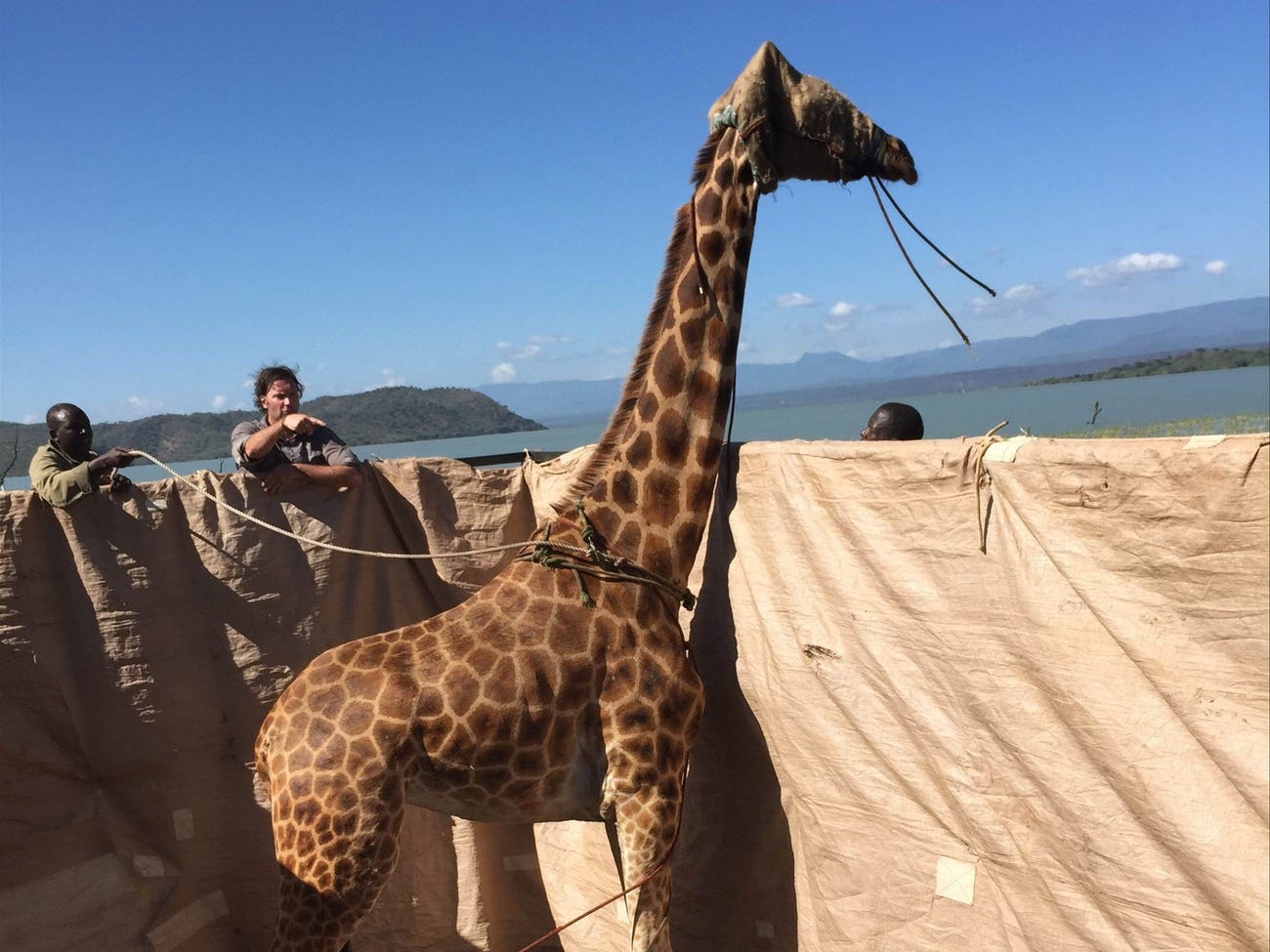
In 2011, conservationists moved eight Rothschild's giraffes to Longicharo Island, a rocky peninsula on Lake Baringo in Western Kenya. The scientists hoped the isolated area would save the endangered animals from poachers and allow their numbers to multiply. However, intense rainfall in August 2020 caused the lake water levels to rise substantially, cutting the area off from the mainland and reducing the once lush, 100-acre habitat to about eight acres.
Local rangers from the nearby Ruko Community Wildlife Conservancy, initially transported food for the starving giraffes, but as the island continued to shrink, it became imperative to relocate the animals to a safer habitat.
While giraffes can swim, Lake Baringo's crocodile-infested waters meant the animals would have to be ferried across. In December 2020, the rangers teamed up with UK-based non-profit organization Save Giraffes Now and the Kenya Wildlife Society (KWS) to construct a custom barge — one that David O’Connor, president of Save Giraffes Now, calls an engineering marvel. “The rectangular steel structure was designed and built specifically to carry tall, heavy giraffe,” he says. “The barge floats atop a series of empty drums for buoyancy. Reinforced sides kept the animals from jumping out as the barge was gently maneuvered by boats."

Their first priority was to save Asiwa, a female giraffe, who was stranded alone in a marshy part of the island with no food sources. However, convincing the gentle giant to get on the barge was not easy. “The giraffes don't know that you're trying to help them,” O’Connor says. “They think you're a predator. So they're really trying to work against you, which makes it even harder.”
After several attempts to lure Asiwa aboard the ferry with succulent mangoes and other treats failed, the scientists had no choice but to sedate her. While the technique is frequently used to transport large animals, it is not the preferred method for giraffes since the change in blood pressure could damage their brains, or they could choke on their own saliva. “It's not like an elephant or a rhino where you just dart it, it flops over, and it's fine,” O’Connor said. “The giraffes, they're kind of like a Formula One car. You can't mess with their innards too much, or they really have problems.”

To prevent any mishaps, the rescuers gave the giraffe a light sedative and then quickly guided her onto the barge. To ensure Asiwa would not panic, they covered her head with a burlap hood and put socks in her ears to block out sound. “The wonderful part was watching her gently amble off the boat once the blindfold was released as if nothing had happened,” said photographer Ami Vitale who documented the rescue. “It really was a scene that could have been biblical.”
The following day, a young giraffe named Pasaka was ferried away in a similar fashion. A third giraffe, a male named Lbarnoti, was rescued on January 27, 2021. However, unlike Asiwa and Pasaka, he was eager to get on the barge and munch on delicious acacia pods during the entire journey. Susan Myers, CEO of Save Giraffes Now, says, "Each giraffe has its own personality. Some are very timid while others are brave and go onto the barge readily."
Weather permitting, the rescuers hope to relocate the island's remaining six giraffes, including Lbarnoti's calf Noelle, by March 2021, to the 44,000-acre Ruko Community Wildlife Conservancy. "Once we rescue them, that’s not the end of it,” O’Connor says. “That’s actually just the beginning of trying to repopulate the entire Western Rift Valley with this type of giraffe, where they became locally extinct 70 years ago.”
Endemic to South Sudan, northern Uganda, and western Kenya, Rothschild's giraffes, which grow up to 19 feet tall, are one of the tallest members of their species, second only to Masai giraffes. The herbivorous animals are easily distinguishable from other giraffes due to their coat, which comprises dark orange and brown patches with beige areas. They also have no markings on their lower legs. While the animals once roamed the plains of Kenya and Uganda in abundance, loss of habitat, drought, and poaching have severely reduced their population. Save Giraffes Now estimates there are fewer than 3,000 Rothschild's giraffes left in the wild — about 800 of which are in Kenya — making them the most endangered members of their species.
Resources: Atlasobsucura.com, Business Insider.com, savethegiraffesnow.com
